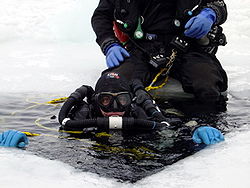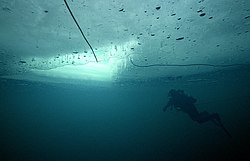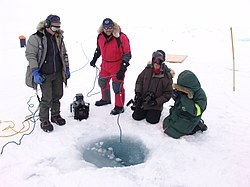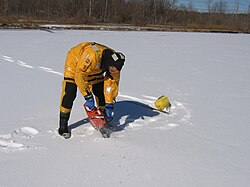
Back Eistauchen German Plongée sous glace French Immersione in ghiaccio Italian IJsduiken Dutch Scufundare sub gheață Romanian Подлёдное погружение Russian







Ice diving is a type of penetration diving where the dive takes place under ice.[1][2] Because diving under ice places the diver in an overhead environment typically with only a single entry/exit point, it requires special procedures and equipment. Ice diving is done for purposes of recreation, scientific research, public safety (usually search and rescue/recovery) and other professional or commercial reasons.[3]
The most obvious hazards of ice diving are getting lost under the ice, hypothermia, and regulator failure due to freezing. Scuba divers are generally tethered for safety. This means that the diver wears a harness to which a line is secured, and the other end of the line is secured above the surface and monitored by an attendant. Surface supplied equipment inherently provides a tether, and reduces the risks of regulator first stage freezing as the first stage can be managed by the surface team, and the breathing gas supply is less limited. For the surface support team, the hazards include freezing temperatures and falling through thin ice.
- ^ Cite error: The named reference
aaus1992was invoked but never defined (see the help page). - ^ Cite error: The named reference
smithsonian2007was invoked but never defined (see the help page). - ^ Cite error: The named reference
Smith and Dituri 2008was invoked but never defined (see the help page).
© MMXXIII Rich X Search. We shall prevail. All rights reserved. Rich X Search